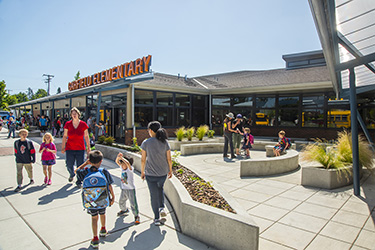|
Subscribe / Renew |
|
|
Contact Us |
|
| ► Subscribe to our Free Weekly Newsletter | |
| home | Welcome, sign in or click here to subscribe. | login |
Construction
| |
 |
August 30, 2018
The view from inside a school: what really makes it safe
McGranahan Architects

McGavick
|
As a society, we have a shared responsibility for vigilance when it comes to the safety of our schools.
At McGranahan Architects, we believe that the design of effective, inspiring learning environments can contribute to keeping the children, families and educators who inhabit them safe. That’s why we chose the topic “Safety and Security” for our recent series of weekly learning sessions.
While much of the focus is on the active shooter, we learned that the topic is broader than commonly thought, including assault, bullying, suicide prevention, school climate, disease, food poisoning and natural disasters.
We invited four panelists from local school districts to join our conversation: an office assistant at an elementary school, an instructional coach and former teacher, an elementary school principal, and an assistant director of safety and security.
We prompted them with two questions: “From your perspective, what makes a school safe and secure?” and “What are the challenges you’ve experienced in creating that environment?”
Discrete measures
Luz is the first person parents, staff and students see when they come in through the front door of her elementary school in Federal Way.
She emphasized the importance of a friendly, welcoming and approachable impression as soon as a student enters the school.
“Some of our scholars are coming to school for the first time and are afraid to be away from the security of their home,” she said. “Not to mention the new parents that are leaving their children at a school for the first time.”
From her perspective, schools in general are becoming more secure, but at the expense of a welcoming experience. She showed our staff photos of schools that resembled detention centers.
Luz’s primary message was one of discrete security, especially for elementary schools: buzzers and ID cards at the entrance instead of a “hardened” look that could potentially startle children and their parents, actually making them feel less safe.
An open environment
As an instructional coach and former teacher, Booth works with teachers during their acclimation to a new school design.
From Booth’s perspective, school design should address the needs of what he calls the “everyday student” instead of a student in the midst of a catastrophic event, such as a school shooting. This means designing for the challenges a student might face on a daily basis, such as bullying, intimidation or harassment.
Booth emphasized the need for transparency to ensure high visibility and allow teachers to work one-on-one with students.
“What do you do in a lockdown?” That’s one of the first questions Booth hears about the open, transparent design of his new school.
Booth challenged designers to re-frame the question and consider the benefits that open, collaborative environments may have on bullying and harassment rates, which have dropped in his new school.
Booth’s takeaway was that we might be asking the wrong questions, which may be leading us to design for the worst-case scenario instead of acknowledging the need to resolve daily safety issues.
Building relationships
Anita, the Tacoma elementary school principal, confirmed the importance of creating a welcoming place, and emphasized relationships as the crux of behavioral problems that could lead to extreme events, such as school shootings.
In her school, many students come from low-income families, with parents who might be unavailable to their children for one reason or another. One of her main concerns is building and maintaining strong relationships — between the school and the community, between teachers/staff and students, but also between the students and their parents/guardians.
She noted, “We have parents who work nights, so bringing their kids in for breakfast and eating breakfast with them is the only time they’re having a connection. So am I going to stop every parent at the door? No. I have to have that trust and have them feel welcome.”
She felt as though “hardening” the entrance of the school discouraged and weakened parent-student relationships that might already be strained. Instead, she emphasized visibility and staff training over traditional security measures.
Safety first
Mike is an assistant security director for Tacoma Public Schools. He is not the first person you see when you walk into a school. Instead, his role in the district is to think strategically and logistically about safety.
Mike echoed some of the sentiments of our other panelists, and was more focused on what he believed to be solutions to safety concerns being discussed on a national level.
Mike acknowledged that schools that look like detention facilities might not be the greatest place to learn and they also may not be effective in preventing a school shooting. He also expressed that “totally open” designs are unsafe and would be equally ineffective in preventing school shootings.
While Mike did provide design suggestions for ensuring safety — such as secure access points — he also recognized the value of relationships, specifically with students and police officers.
He called for a culture shift for both students and parents in building relationships with police officers and implementing security-based design measures: “We want parents to understand that we’re not doing it [implementing security] to make them feel uncomfortable, we’re doing it to make their kids safe.”
Remaining questions
The key questions we are left with are these: Does an open and welcoming environment equate to a sense of safety and security through beneficial connections that foster healthy, nurturing relationships? Can we provide adequate security through strategies that are experienced in the background? Do we design for the everyday interactions among adults and children that address the diverse aspects of safety and security, or do we focus on the relatively rare occurrence of an active shooter, from within or without?
This broader approach to our planning and design conversations will lead to the creation of learning environments that provide a sense of safety to help children through all the daily challenges they face, in and out of school. Our school designs should support a culture that is attentive to the most threatening occurrences, yet mitigates the chances of those occurrences by cultivating a thriving learning environment that provides welcoming experiences and a sense of belonging to a nurturing community, every day.
Michael McGavock is the principal for Learning Environments at McGranahan Architects, leading the engagement, inquiry and planning of meaningful places for learning.
Other Stories:
- It's much easier for schools to get to net zero
- How enviro consultants can lend your school project a helping hand
- UW Life Sciences Building: giant firs and bird songs offer a one-of-a-kind elevator ride
- 3 keys to building green schools: design, operations and renewables
- Bremerton alternative school breaks down walls to learning
- Studies suggest design really can affect how well students learn
- Eastside Prep’s versatile arts hall made for concerts, plays and yoga
- After two decades, UW’s SLU campus nears completion
- How playgrounds make all children feel welcome
- See-through schools spark interest in learning
- Schools have more ways than ever to go green
- OSU football center opts for flexible lighting scheme
- Stretch your tight budget by getting creative
- Long-distance teams worked in concert to remake Wyoming school theater



